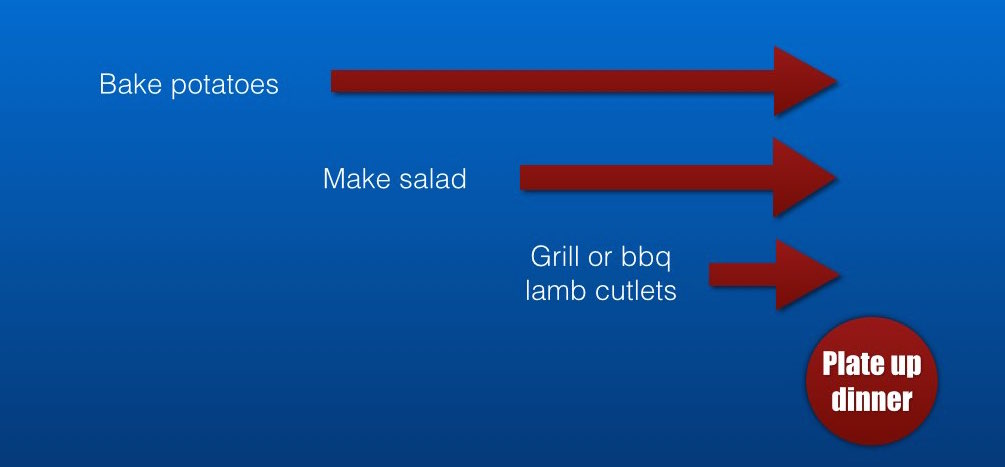5 ways to cook fast, healthy dinners

These days everyone is busy and the phrase ‘time-poor’ seems to be on everyone’s lips. However, there are 5 easy tips and hacks you can use that will enable you to cook healthy dinners without taking an hour. You just need to streamline the process so everything's ready at the same time (believe me, I know!). In this post I show you how.
1. Plan your dinner meals ahead
If you want maximum efficiency, plan and shop for 7 dinners ahead so you know you have everything on hand.
If you can’t plan a whole week in advance, plan for the next two night’s meals so you streamline your shopping and have things ready in the fridge and pantry.
At the very least, don’t leave the house in the morning without deciding what you’ll cook that night. Pull something out of the freezer to defrost or stop at the shops on the way home. Especially if you’re feeding a tribe or a couple of hungry teens.
Use a 7-day dinner planner: print out the shopping list for fresh ingredients, check what you have in the cupboard and freezer, then shop for what you don’t have to make the meals.
2. Build your repertoire
Find and practice 7 or 10 recipes that you can cook regularly and you know everyone loves. At our place, it was Spag Bolognaise, oven-roasted chicken with roast veg, a tuna pasta bake and my easy Chicken stir-fry (which always varied depending on the veges on hand).
Write the recipe titles out on a piece of A4 paper (call it your "Recipe List") with the quantity of key ingredients you need to buy and carry this in your bag or store them on your mobile phone. That way, if you’re on your way home or at the shops, you can quickly pick up those main ingredients to create a quick meal.
Here are three simple examples with their key ingredients for four plus a bit for leftovers:
Spaghetti Bolognaise – you’ll need:
500g lean beef mince
750 bottle or can of tomato pasta sauce
250g dry spaghetti (which is half a 500g pack)
PLUS
onion, garlic, mushrooms, wine (optional), salad ingredients
Beef Stroganoff – you’ll need:
500g rump steak
750g button mushrooms
1-2 tablespoons tomato paste
250g tub sour cream
PLUS
onion, stock, flour, fresh parsley (optional), green beans or salad ingredients
Barbecued fish – you’ll need:
4 fish fillets or small whole fish
4 medium potatoes for baking or wedges
1 lemon
Bunch of fresh dill
PLUS
salad ingredients
Want meal inspo? When you run out of ideas, just run your eye down your recipe list and see what grabs you.
3. Start cooking the longest first
Read over the recipe or meal idea. Decide what item takes the longest to cook and plan to start cooking that first, then the next longest and so on, so everything is ready at the same time.
For example, say you want to prepare a dinner of grilled lamb cutlets, baked potato wedges with a large Greek salad. Ideally you’d cut and get the wedges in the oven first (takes 30 minutes), then make up the salad (takes 10 minutes) followed by grilling the cutlets at the end as they’re quick (another 10 minutes).
4. Work Ahead
Prepare and get whatever you can, done earlier in the day so you’re more relaxed at dinnertime. Let’s face it – evenings are hectic times for most families. Kids are tired and hungry. They have to be bathed and fed, school-aged kids have homework, pets are waiting to be walked and fed. It makes a huge difference if you can keep stress levels down by having some steps semi-ready.
Examples:
- Bowl of salad (lettuces, cucumber, onion, tomato etc.) torn or sliced and sitting covered in the fridge waiting for a dressing before eating.
- Chicken pieces or beef steaks, unpacked, trimmed of fat and ready to grill or oven bake.
- Vegetables like potatoes, kumera (sweet potato), pumpkin, parsnip, carrots, beans or broccoli already diced and sitting in a pot or the sink covered with water read to be steamed or boiled.
Tip: Cut vegetables into pieces about the same size so they all cook evenly. If you’re cooking one pot of different veges, cut the tougher, denser ones into smaller dice (carrots, pumpkin) so you can cook together with larger chunks of the softer quick-cook types (zucchini, asparagus), or add the softer ones for just a few minutes towards the end of the cooking time.
5. Clean up as you cook

Keep your work space clean and uncluttered. Rinse plates and stack in the dishwasher or pile up ready for a wash-up. Wipe down boards and surfaces as you go.
If you have a 5-minute spell, do a partial wash up so it’s not all sitting there waiting for you AFTER dinner. Have all your utensils within easy reach. Make sure you have all the ingredients you need BEFORE you start to cook.
Two handy tips to cut down on washing up:
- Line baking trays and bakeware with a sheet of parchment (baking) paper. When done, you simply throw away the paper (it’s recyclable) and give the trays a quick wash.
- Look for all-in-one recipes such as stir-fries in one wok or an oven bake in ONE baking dish. Saves on washing.






